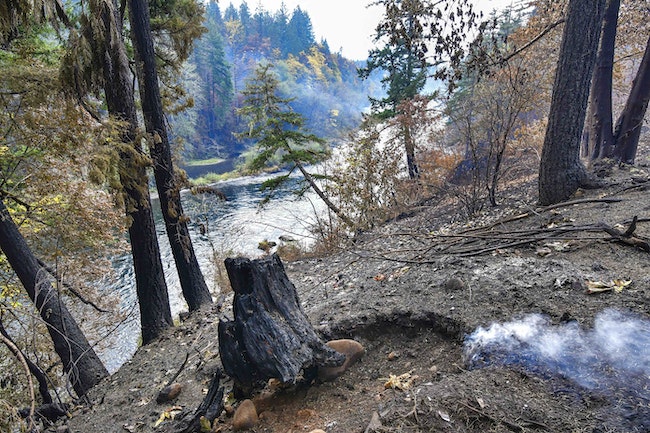
Smoke curls from fire still burning within view of the North Santiam River. The north side of the river was badly damaged by wildfires but large areas of the south side largely escaped. (Ron Cooper/Salem Reporter)
Federal and local agencies are facing bureaucratic and logistical challenges as well as a housing shortage as they seek to find shelter for residents displaced by last month’s wildfires
One month after the wildfires ripped through the Santiam Canyon, dozens of families are still searching for apartments or trying figure out what it will take to rebuild a home.
Santiam Hospital’s Service Integration Team has stepped in to help, working with housing agencies in Marion County to help find permanent homes while the Santiam Canyon begins the long process of rebuilding.
St. Francis Shelter, the Mid-Willamette Valley Community Action and Marion County are working in tandem to address the different populations displaced by the fire, like those who were already facing homelessness and those receiving federal housing subsidies.
Melissa Baurer, who runs the team, said the vacancy rate for rentals in the Santiam Canyon region is less than 1%.
St. Francis Shelter has a master list of those who need housing. Baurer said there are 70 households with nowhere to return to. They don’t have an RV, relative or someone who will let them sleep on their couch. And most want to stay close to their community, which makes finding housing even more difficult.
“Silverton has offered up their senior housing, but we haven’t found a senior on the long-term housing list that at this point is willing to move to Silverton,” Baurer said. “That’s challenging. The market was already really bad. We could hardly find apartments for anybody prior to this.”
Gabriella Cordy, a housing specialist and case manager at St. Francis Shelter, said her organization secured permanent housing for its first two families this week. One was willing to relocate to Silverton and the other to Salem.
The agencies are helping those displaced by the wildfires with moving costs and trying to find available rentals. The process becomes more complicated for those who were renting using federal housing vouchers, which not all landlords accept, or with large families.
The lack of housing stock in Marion County is so dire the Federal Emergency Management Agency this week agreed to send manufactured housing units, commonly called “FEMA trailers,” to those displaced in Marion, Linn and Jackson counties.
Jann Tracey, FEMA spokesperson, said in Marion County there are 52 applicants who may be eligible for such housing.
“They need to show not only the need for the manufactured housing unit, but also that there’s a plan to get them back into their own home,” she said.
Tracey said the number of mobile units offered will be based on the need, but the process to site them could prove time consuming because FEMA has to follow the county’s permitting rules to locate the trailers.
In Marion County, 1,185 people have registered for disaster assistance through FEMA, Tracey said.
She said wildfire victims have been moved out of temportary shelters in Oregon, but statewide there are 2,000 people in hotels, a program that will run until December.
FEMA is also offering rental or security deposit assistance for families, but Tracey pointed out that one of the difficulties is that more than half of the housing lost or damaged in Oregon’s wildfires were mobile homes, which adds another hurdle in finding affordable replacements.
Some have moved into donated trailers while they wait for something more permanent.
In one case, SIT bought a water hose, electrical cords and a generator for a family living in a trailer donated by someone from eastern Oregon.
“You get them into a little bit better situation then they were in,” Bauer said.
Cordy said it could take months to get the list of people housed.
FEMA has an external outreach center on 400 W. Virginia St. in Stayton for wildfire victims to go over their disaster assistance applications and track them. It’s open from 8 a.m. to 6 p.m.
Have a tip? Contact reporter Saphara Harrell at 503-549-6250, [email protected] or @daisysaphara.
SUPPORT SALEM REPORTER’S JOURNALISM – A monthly subscription starts at $5. Go HERE. Or contribute to keep our reporters and photographers on duty. Go HERE. Checks can be sent: Salem Reporter, 2925 River Rd S #280 Salem OR 97302. Your support matters.









